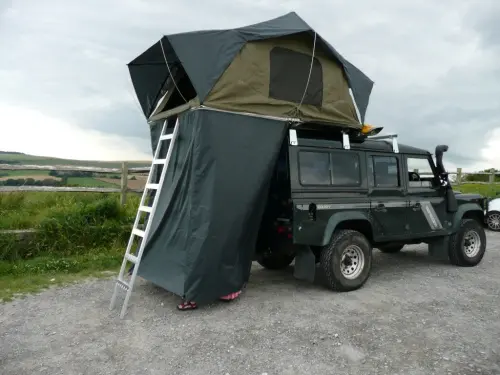
The Background – The Tent Problem
We have been trying to find the right sleeping solution for the three of us since, pretty much the first trip we ever went on. The problem we have always had is that we would prefer to be able to wild camp or free camp, but having a family tent made this almost impossible. Not to mention the time it takes to put up and take down a larger tent.
In the years that followed we moved onto two small back packing tents one for Cassie and one for us. A two and three man. The plan being in camp sites we use both, in the bush we use one. What we often found though, was that it was hard to find a decent spot for the Landy and a three man tent. If we were walking it would have been fine.
We used the family tent for two years, then the small tents for about two years. We eventually slimmed our arsenal of tents down to the family tent, which will be sold this year, it was only kept for the in-laws on this last trip; the three man backpacking tent we will keep for walking and biking; Cassie’s pop up tent and now the latest addition is a roof tent.
The Sleeping Solution
On this trip we took the pop up tent and the new roof tent. The plan being that we would all sleep in the roof tent in the wild, then at campsites we would use both tents to allow us to get a good nights sleep, without being kicked and punched by Cassie all night.
Enquiries about purchasing the roof tent started about 6 or 7 weeks before we left. We were hoping to go and check one out, then get one shortly after. What ended up happening actually, was that we got really busy and were not able to get to a place to see one, it was quite a way. What also happened was that we had to wait for a delivery from Cape Town, South Africa by sea. Luckily we were able to secure one of the items which had already departed in the next batch to be delivered.

We ended up paying a deposit and hoping the tents would not be delayed in customs. They were supposed to clear by the first week of July. We thought that would be perfect as we could get a couple of nights camping in to make sure everything was ok. Inevitably that did not happen as you would expect, nothing is that simple. We managed to get the tent the Friday before we left. Paul from Myway came down from Doncaster to fit it and train us! Which was a nice touch. Needless to say the tent is superb. One thing led to another and we were not able to get out camping that weekend, so would have to just wait till the actual trip. Fingers crossed everything would be ok!
How to Use and Open a Roof Top Tent
In the end we did manage to find time on the Southdowns to practice putting it up and down including the shower curtain. We also managed to get a few pictures of the process. The pictures below were taken in France.
- Step 1 – Position Car, for a comfortable night’s sleep you need the vehicle level, no overlander functions well on a shitty night of sleep.

- Step 2 – Remove Cover and Insert Ladder. The cover is easy to unzip and then lift and flip out of the way

- Step 3 – Close the Door and reach for the ladder! The tent is pivoted open using the ladder, it is really easy to unfold because the ladder offers purchase.

- Step 4 – Rotate about the hinge and open. As the tent opens, use the ladder to control the descent of the base.

- Step 5 – Remember something you forgot.

- Step 6 – Position ladder and fit stays for the flysheet. The stays are easy to fit into the fly sheet and the base, the spring steel stays hold the fly sheet nice and tight.

- And Relax!

Having spoken at length with Paul, we ended up with a Serengeti 1.6m tent, we had originally wanted to get an Evolution because it was lighter and not canvas and we wanted a 1.8m as it was wider. Paul assured us that the Serengeti was a good choice and that a 1.6 was plenty wide enough for us and Cassie. He was so confident that he assured me if we were not happy we’d sort “something” out! The man proved to know his stuff. The other advantage of the Serengeti was that the canvas would keep the light out in the morning. We found it easy to sleep till nine at times.
How Much does a Roof Top Tent Weigh
In writing this so far, I’ve missed a beat, in between paying a deposit and getting the tent I had to find a platform to mount the tent to on top of the Landy. I spent quite a lot of time trying to work out if I wanted a roof rack or roof bars. Roof tents in general are heavy. Myway tents are lighter than most, the 1.6m we were waiting for weighed in at circa 50kg. Most are about 20kg more, with some hitting the 90kg mark for family models. A decent roof rack is about 40 to 50kg, with the Landy and a lot of other cars rated at about 100kg for roof loads, I’d want the lightest mounting system possible. Roof bars are about 5kg approximately each. It seemed an obvious choice considering we did not need a rack at the moment and could do with saving some money.

I found various bars around, I wanted something sturdy though. Really because of the off roading factor and mounting the awning. I toyed with getting some boab / mantec bars, I forget what they are called, but dismissed that because I was not convinced they were robust enough for us. Boab also, did some other bars called Boab bars in a 40mm x 40mm or 40mm x 20mm section. I opted for the 40mm square option. I ordered three of these as I needed to mount my awning using u-bolts. This offered a significant weight and cost saving over a rack.
Construction and Use
In terms of construction the tent is made on an aluminium base frame which uses stainless brackets and bolts with aluminium rivets in places, this has a marine ply base attached via captive nuts and bolts. The base frame has a bolted stainless hinge arrangement on either side of the frame, this is the point at which the aluminium hoop tubes attach which support the main tent canvas. The canvas hangs on the hoops, this allows the fly sheet to lay over the top of the whole arrangement. This leaves about a 40 or 50mm gap between the inner tent and flysheet, depending on how the two are adjusted. This gap allows plenty of airflow and is probably a contributing factor to the lack of condensation.
Season Roof Top Tent – Is it Waterproof
The canvas inner tent is coated with a waterproofing agent, as is the flysheet. With this coating the canvas is free from the normal leaks you get on the first outing and as such we did not need to specifically “season” the canvas, although you can if you would like.
If that is the case and you would like to season the canvas. Seasoning would normally be achieved by repeatedly watering/wetting the canvas and letting it dry.
Not seasoning did not mean we escaped unscathed. We suffered a small amount of leaking on the first night due to the fly sheet being incorrectly adjusted and hanging on the inner canvas, it was a very minor leak and we did not see the issue again after we adjusted and experimented a little.
Comfort – Roof Top Tent Mattress
The tent is delivered with about a 40mm sponge mattress and a fitted green sheet. The foam is covered in nylon so you need the sheet. The mattress cover is arranged such that it hindges in the middle and folds flat when the tent is packed away. We found the mattress fairly soft, so was easy to feel the base underneath, it took a little getting used to. We tended not to notice so much when we slept in sleeping bags in colder climates.
It is possible to leave some bedding in the tent when it is packed away, but it must be folded flat before the tent is folded. It should be left on the fixed half of the tent. Failure to fold the bedding flat will result in it bunching when the tent is put away and putting extra strain on the hinge, which could lead to failure of the hinge if excessive.
Roof Tent Problems and the Solution
After a few nights we did discover one issue with the tent, which we now have a solution for.
This came about due to a design change, apparently ours is one of the first of a new design. The cross member behind the hinge tended to sag by approx 10mm, this put a noticeable step in the middle of the base, between the two halves of the tent. Unfortunately we could feel this through the mattress.
Tents before the design change had some locating pegs to ensure the cross members of the two halves were mechanically linked, so any sag was minimised and mutual, this most importantly avoided a difference in the two plywood base halves. In order to remedy this we will be installing some locating pegs, which will actually be formed by the cap heads of some stainless steel bolts. These will interface to locating holes on the second half cross member which folds down. The important thing about this issue was that it did not prevent us from enjoying the tent and when we got back, Paul offered some brilliant support for discussion to come up with a solution.
On the underside of the folding half of the tent a channel is mounted to the base. This allows the addition of a “shower curtain” which is essentially three sides of a walled room with no ground sheet and a small cut out for the ladder, the Landy forms the fourth wall. The ladder is outside the room. We tried this briefly on the Downs but never used this on the trip. The way we have the tent mounted means that it would provide shelter at the back of the Landy into the rear door during inclement weather, with the door open. The additional kit comes in a small bag, so is light enough to carry around. I just never want to have to use it. It takes 2 or 3 minutes to install.
Conclusion
Apart from the minor niggle above, we had a great time with the Serengeti this holiday. We enjoyed the quick set up and pack away times. Wendy and I got quite a good routine established that meant we could put our feet up quicker and be on the road sooner.
The benefit of the quick set up time means it gives more confidence for camping discreetly as it can be set up at dusk and packed away at dawn when no one is around. This is one of the reasons roof tents are so popular.
In terms of quality, the construction is excellent and modular, so if something needs changing it can be and would be fairly simple, probably without having to go to Myway for spares. The only thing I would pick up Myway (the factory) on is the construction process. We found a lot of swarf in the tent and on the aluminium components. This was because the components are drilled during assembly, rather than drilled cleared and then assembled. It would not be hard to fix this process issue and would save some customer annoyance.
In short I would not be able to compare against other roof tents as I have not had the chance to look at them, but I can say with confidence that the Myway Serengeti 1.6 meter is an excellent buy.
Get one!

Dan’s a windsurfing, adventure-seeking nomad with a passion for exploring the globe overland and an Engineer. Having grown up in the Middle East, he brings a unique perspective to Getting Lost Again, sharing his love for discovering hidden gems and embracing the unexpected. When he’s not on the road, he finds inspiration in windsurfing and other creative pursuits – and is equally at home under a vehicle solving problems as he is exploring a new place.
